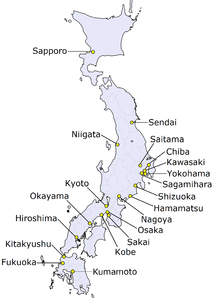Cities designated by government ordinance of Japan: Difference between revisions
→External links: clean up using AWB |
m →Overview: Small punctuation change that clarifies the sentence |
||
| Line 9: | Line 9: | ||
Designated cities are also required to subdivide themselves into {{nihongo|[[wards of Japan|wards]]|区|ku}}, each of which has a ward office conducting various administrative functions for the city government, such as [[koseki]] and [[juminhyo]] resident registration and tax collection. In some cities, ward offices are responsible for business licensing, construction permits and other administrative matters. The structure and authorities of the wards are determined by municipal ordinances. |
Designated cities are also required to subdivide themselves into {{nihongo|[[wards of Japan|wards]]|区|ku}}, each of which has a ward office conducting various administrative functions for the city government, such as [[koseki]] and [[juminhyo]] resident registration and tax collection. In some cities, ward offices are responsible for business licensing, construction permits and other administrative matters. The structure and authorities of the wards are determined by municipal ordinances. |
||
The [[Special wards of Tokyo|23 special wards of Tokyo]] are not part of this system, as [[Tokyo]] is a prefecture and its wards are effectively independent cities. Although the two largest wards of [[Tokyo]] |
The [[Special wards of Tokyo|23 special wards of Tokyo]] are not part of this system, as [[Tokyo]] is a prefecture and its wards are effectively independent cities. Although the two largest wards of [[Tokyo]]: [[Setagaya, Tokyo|Setagaya]] and [[Nerima, Tokyo|Nerima]], are populous enough to become designated cities, they are not considered to be "cities" within the meaning of the Local Autonomy Law and therefore cannot be designated. |
||
No cities that have been designated by government ordinance have later lost this status. |
No cities that have been designated by government ordinance have later lost this status. |
||
Revision as of 07:14, 10 January 2010

■ ― Designated cities
■ ― Core cities
■ ― Special cities
A city designated by government ordinance (政令指定都市, seirei shitei toshi), also known as a designated city (指定都市, shitei toshi) or government ordinance city (政令市, seirei shi), is a Japanese city that has a population greater than 500,000 and has been designated as such by an order of the cabinet of Japan under Article 252, Section 19 of the Local Autonomy Law.
Overview
Designated cities are delegated many of the functions normally performed by prefectural governments in fields such as public education, social welfare, sanitation, business licensing and urban planning. The city government is generally delegated the various minor administrative functions in each area while the prefectural government retains authority over major decisions. For instance, pharmaceutical retailers and small clinics can be licensed by designated city governments, but pharmacies and hospitals are licensed by prefectural governments.
Designated cities are also required to subdivide themselves into wards (区, ku), each of which has a ward office conducting various administrative functions for the city government, such as koseki and juminhyo resident registration and tax collection. In some cities, ward offices are responsible for business licensing, construction permits and other administrative matters. The structure and authorities of the wards are determined by municipal ordinances.
The 23 special wards of Tokyo are not part of this system, as Tokyo is a prefecture and its wards are effectively independent cities. Although the two largest wards of Tokyo: Setagaya and Nerima, are populous enough to become designated cities, they are not considered to be "cities" within the meaning of the Local Autonomy Law and therefore cannot be designated.
No cities that have been designated by government ordinance have later lost this status.
List of designated cities and their wards
| Administrative divisions of Japan |
|---|
| Prefectural |
| Prefectures |
| Sub-prefectural |
| Municipal |
| Sub-municipal |

- The ward's name in bold is where the city hall is located.
Designated city Requirements
- A population greater than 500,000.
Application for designation is made by a city with the approval of both the city and prefectural assemblies.
Scheduled to become a designated city
| Region | Prefecture | Designated City |
Date of designation |
Wards | |
|---|---|---|---|---|---|
| Number | List | ||||
| Kantō Region |
Kanagawa | 相模原 (さがみはら) |
2010-04-01 | 3 | Midori, Chūō, Minami |
Cities that meet the requirements and nominated
 Kumamoto, Kumamoto Prefecture - 2012
Kumamoto, Kumamoto Prefecture - 2012
History
The first form of the designated city system was enacted under Japan's first formalized local government system in 1878 with the introduction of "wards." Under this system, wards existed in every city: most cities had only one, but the largest cities at the time—Tokyo, Osaka and Kyoto—were divided into 15, 4 and 2 wards respectively.
The municipal system enacted in 1889 replaced ward assemblies with city assemblies, but retained ward assemblies in Tokyo, Osaka and Kyoto: in these cities, the city had no assembly of its own but was rather governed by the prefectural assembly. In 1898, these cities were allowed to form city assemblies. This ward system was adopted by three more cities prior to World War II: Nagoya (1908), Yokohama (1927) and Kobe (1931). Under a 1911 statute, wards were granted corporate personality and treated as local entities.
Following the war, the 1947 Local Autonomy Law grandfathered in the five subdivided cities (Tokyo having become a prefecture in 1943) as special cities (特別市, tokubetsu shi). This system was replaced by the designated city system when the Local Autonomy Law was amended in 1956.
During the ensuing Japanese economic growth period, the government required designated cities to be forecast to reach a population of 1 million within the near future, but this requirement was dropped in 2005 in order to accommodate several geographically large cities formed by mergers under the Koizumi government.
